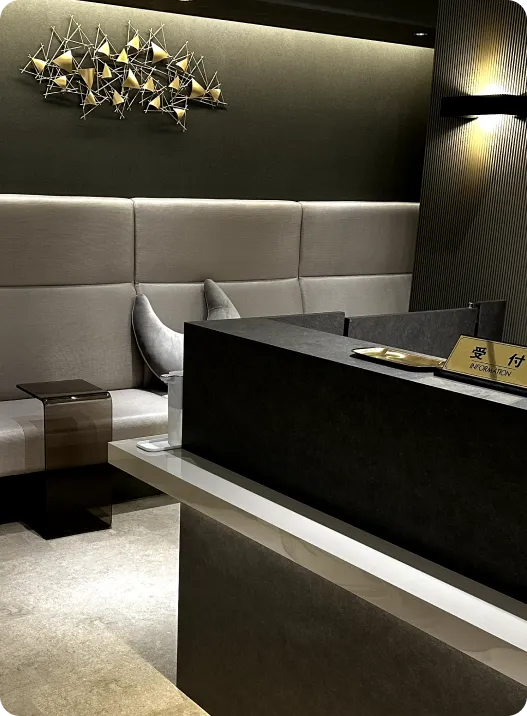Book Appointment
After your inquiry, our staff will schedule your visit and confirm your reservation.
Humans typically have 100,000 to 150,000 hairs, with hair growth naturally stopping after reaching a certain length—2-5 years for men and 4-7 years for women. Once cell division halts at the hair bulb, hair enters a 3-week regression phase, followed by shedding. New hair begins to grow within 4-6 months. However, factors like excess male hormones, stress, and poor scalp circulation can shorten the growth phase, leading to hair loss.



Our bodies have the ability to regenerate and replace lost cells, such as those in the skin and blood, to maintain tissues that are constantly renewed. These cells, known as “stem cells,” have two key abilities: differentiation (the ability to create various types of cells, such as skin, red blood cells, and platelets) and self-renewal (the ability to divide and produce identical copies of themselves).
Stem cells are categorized into two types. One type is “tissue stem cells,” which continually replace lost cells in specific tissues and organs, like skin and blood. These stem cells are specialized for particular roles, such as hematopoietic stem cells that produce blood cells and neural stem cells that generate cells for the nervous system. The other type is “pluripotent stem cells,” such as embryonic stem cells (ES cells), which have the potential to become any type of cell in the body. In essence, pluripotent stem cells can generate various tissue-specific stem cells.
Induced pluripotent stem cells (iPS cells) are a type of pluripotent stem cell artificially derived from ordinary cells.
Research into regenerative medicine, which harnesses the properties of stem cells to treat injuries and diseases, is progressing. Scientists are also exploring disease mechanisms by recreating the cellular environment outside the body for study.

Hair is produced in the bulge area at the base of the hair follicle, where "hair follicle stem cells" undergo cell division to generate new hair. When the function of these stem cells declines, the hair growth cycle from resting to growing phase is disrupted, leading to hair cycle abnormalities.
At Artisan Clinic Hibiya, we inject adipose-derived stem cells directly into the scalp to activate hair follicle stem cells, restoring the normal hair cycle and stimulating hair growth. The stem cells also activate "progenitor cells" around the hair root, whose growth factors stimulate dormant hair follicle stem cells, triggering the transition from the resting phase to the growing phase and promoting hair growth.
A license is required to provide regenerative medicine In order to provide regenerative medicine, based on the Act on Ensuring the Safety of Regenerative Medicine, a specific authorized regenerative medicine committee has It must be reviewed by the Ministry of Health, Labor and Welfare and accepted by the Ministry of Health, Labor and Welfare. Artisan Clinic Hibiya is a medical institution that has been accepted by the Ministry of Health, Labor and Welfare for a provision plan for knee joint stem cell administration.



After your inquiry, our staff will schedule your visit and confirm your reservation.

After you complete the questionnaire, the doctor will explain stem cell treatment and recommend a plan suited to your health condition.



Stem cells are harvested from abdominal or buttock fat. 20 grams of adipose (fat) cells are extracted and it can be cultivated into 20 sessions of stem cell therapy. There is only a very small wound of 1 cm to harvest the fat.

We will culture stem cells and exosomes over about 4 weeks. To maintain optimal conditions, please avoid changing or canceling the administration date once scheduled.



For Intravenous Drip: Disinfect > Confirm injection site > Insert needle > Secure tubing.
Duration: 40-60 minutes.

Before leaving, our staff will provide post-treatment instructions. You may go home the same day, but please avoid driving for safety. Contact us with any concerns, and our team will respond promptly.


No, hospitalization is not required. Stem cells are collected during the first visit, and the administration takes place during the second visit. However, a 4-week cell culture period is needed between collection and administration.

Skin sampling is done under local anesthesia, similar to a dental procedure. The skin collected is about 5 mm, and after a month, it becomes almost unnoticeable you can't even tell where it was taken.

The effectiveness of stem cell therapy can vary significantly between individuals, but a general guideline is that results may be seen within 3 to 6 months.

Stem cells are distributed throughout the body. While adipose (fat) tissue has traditionally been known for its high concentration of stem cells, advancements in cultivation technology now allow for equal or even greater stem cell yields from skin and subcutaneous fat. Recognizing that patients may be hesitant about liposuction, our clinic instead collects stem cells from subcutaneous fat under the skin.

Medical expenses may qualify for a deduction if they are related to treatment. For detailed information on how to proceed, please reach out to your local tax office. Be sure to keep the receipt provided by our clinic for your records.

As it is a specialized medical treatment, the full cost will be covered by the patient, and it is not covered by insurance.










